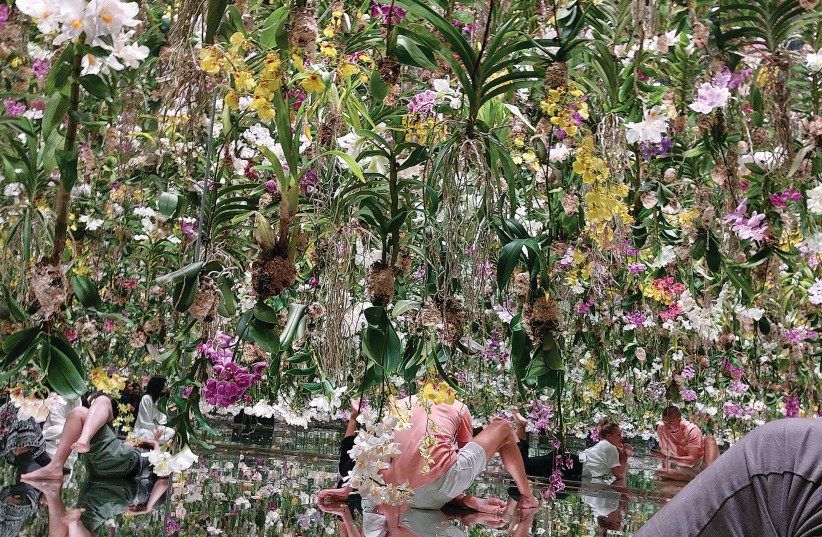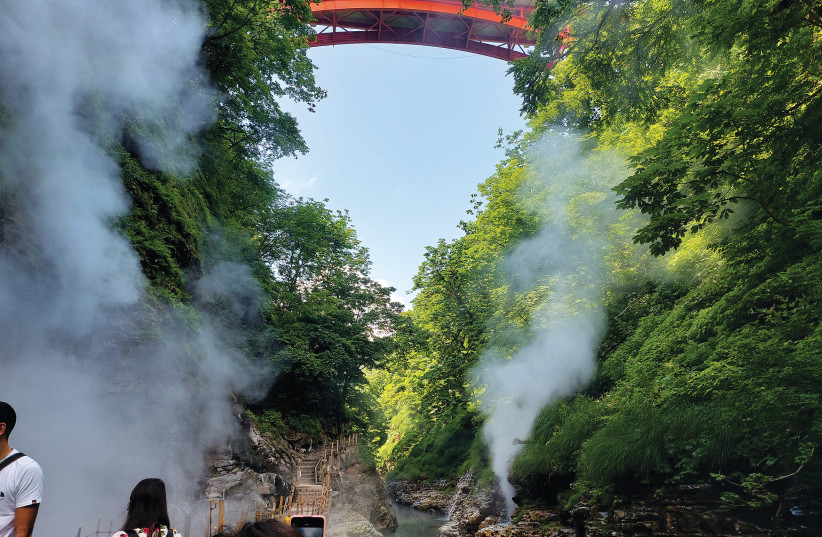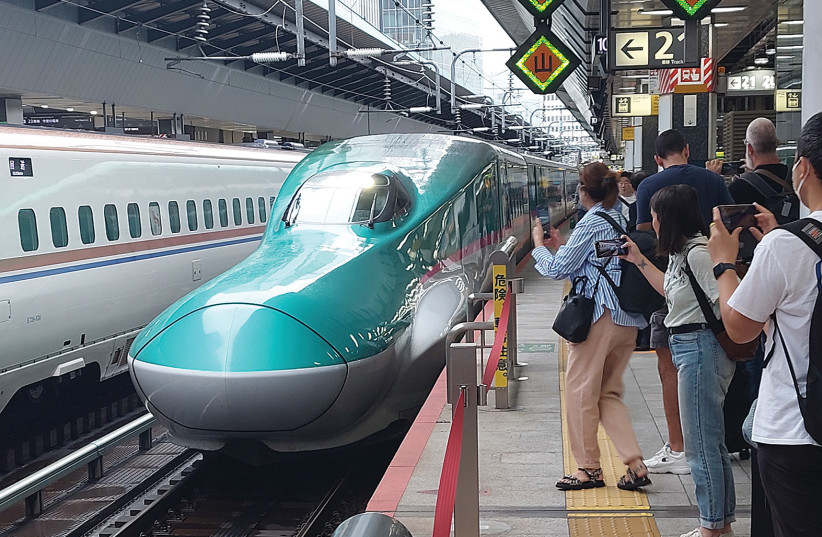It was 9.30 p.m., less than 24 hours since we arrived in Japan. Along with two new Israeli friends and a handful of Japanese men, I unexpectedly found myself totally unclad in a hot spring in a rundown indoor spa in Kakunodate, a small village in the Akita region some 600 km. north of Tokyo.
The “hot” was a misnomer, for the water was scorching, endangering all appendages that dared enter. But submerge ourselves we did, intent on an authentic Japanese experience.
After 10 minutes, red as beets, we threw in the towel so to speak, dressed, and joined the female members of our small entourage of Israeli writers in the lobby. They had lasted even less time on their side.
We all bought bottles of energy water from the vending machines that we would learn are ubiquitous throughout the country and contain everything from snack food to sandwiches to toothpaste.
Our tour guide, Ryoko, who was forced to be by our side on this unscheduled jaunt, was surprised that after an overnight flight and a jammed day beginning with an 8 a.m., three-hour bullet train journey to the region, we preferred to trudge the empty streets of Kakunodate with towels over our shoulders for a kilometer, over the prospects of snuggling into a comfortable bed.

But that proved to be the template for the four days we spent in Japan as guests of El AL and the Japan National Tourism Organization (JNTO) – experiencing as much as possible, both scheduled and impromptu. The objective of the lightning visit was to introduce the new non-stop route between Tel Aviv and Tokyo, and to present some of the lesser-trodden tourist destinations in the country that was brand new to most of us.
The twice-weekly flight on El AL’s Dreamliner had been due to commence in March 2020, but was postponed after the outbreak of the COVID pandemic. Beginning in earnest in March, the flights are in full swing and have proved to be both convenient and comfortable.
Our flight was full, mostly with Israelis, some in groups like us bound for an organized tour, and others heading to the country for an adventure of their own. Now it takes about as long for Israeli travelers to get to Japan as it does to New York, and the 11:30 p.m. departure time contributes to the likelihood that you’ll be refreshed upon landing (Japan is six hours ahead of Israel).
However, distractions abound, even in the roomy Premium Plus section, including some truly excellent meals and a wide-range entertainment system. (I recommend watching the great Bill Murray-Scarlett Johansson film Lost in Translation to get in the proper mood for touring Japan.)
Landing at 4 p.m. Tokyo time, we were met by Ryoko, a real outdoorswoman who usually guides groups up Mount Fuji. Instead of heading to our hotel, she herded the group directly to our first stop – a destination that emphatically soaked into our stimulus-filled brains that we weren’t in Tel Aviv anymore.
TeamLab Planets, (https://planets.teamlab.art/tokyo/) in Tokyo’s Toyosu neighborhood, is called a digital museum, but it’s unlike any I’ve ever seen. Visitors are instructed to put their shoes in a locker, roll up their pants to knee level and slip on rubber sandals that are readily available, as they climb a man-made waterfall and immerse themselves in pools that test the boundaries of perception.

Comprised of four large-scale artwork spaces and two gardens, it allows visitors to completely submerge their bodies in enormous and interactive artworks – including such otherworldly phenomena as walking on water, merging with more than 13,000 orchids, and blurring the perception of boundaries between the self and the works.
“Mehamem” (amazing) was the repeated reaction from our pre-jet-lagged group during the 90-minute visit. I recall some hallucinatory experiences in my distant past, and this matches the best of them. The place was packed, so reserve in advance.
ALREADY TURNING Japanese, we had our first local dinner at Monja Fugetsu in Tokyo’s Tsukishima district (we really had no idea where we were). An unassuming and decidedly non-touristy establishment, Fugetsu features monja, a traditional food said to have originated in Tsukishima.
It’s described as a Japanese soft pancake with filling, including vegetables and cheese, and a choice of fish, seafood, chicken, or beef, that is grilled on your table in front of you – with you doing much of the work yourself. It was loads of fun, aided by some Japanese beer.
My intense anticipation to have authentic Japanese sushi would have to wait a day. Tokyo seemed larger than life, with neon and buzzing activity at every turn. However, by the time we got to the Celestine Tokyo Shiba hotel, (https://www.celestinehotels.jp/Tokyo-shiba) it was lights out in preparation to leave the hotel at 7:30 a.m. to catch the bullet train up North.
Our hosts from Israel had prepped us that the Japanese are very punctual and that the apparently well-known Israeli trait of Middle Eastern tardiness would not be tolerated.

We made them proud by showing up on time, and after a quick taxi ride, we arrived at the labyrinth-like Tamachi train station. Ryoko was briefing us at the entrance about the path we were going to take to get to our track where the train was leaving in a few minutes, when I felt for my phone and discovered I had left it on the seat of the taxi.
I could see the panic in Ryoko’s eyes as she started speaking in Japanese and quickly got on her phone. Within five minutes, the taxis squealed into the drop-off area, and the driver ran out holding my phone, and presented it to me with two hands, in the traditional Japanese manner, as everyone clapped. We then hauled ourselves through the terminal, down escalators, through turnstiles, up sets of stairs, through hordes of travelers, all done in single file like a military campaign led by a short Japanese guide.
The famous Shinkansen bullet train
We arrived at the track with a few minutes to spare, but my fate for the rest of the visit was sealed as the forgetful Israeli who looked responsible but who almost made us miss the Shinkansen bullet train.
And what a train ride it was – traveling upward of 300 km. an hour for three hours through gorgeous countryside, dominated by rice paddies, mountain views, and rivers. After the electricity of Tokyo, if only for a few hours, it was like hurtling back a century.
That feeling was reinforced when we arrived in Kakunodate, a small village in Akita, known as a popular destination during the cherry blossom season, which we missed by a month or so. The town’s inn, the Hotel Folkloro was in the square adjacent to the train station, as was the town’s police station – sort of like a Japanese version of Mayberry.
Those basic, but more than adequate accommodations, were our base for the next two days of eating amazing meals, touring samurai villages, walking through steamy gorges, and of course, visiting the scalding neighborhood hot springs spa.

Because the region is relatively new to visitors – both domestic and foreign – a vibrant boutique tourism industry has developed with energetic entrepreneurs offering unique experiences.
One of them is Makito Kochihira, an endearing 26-year-old who offers tours of the area and owns a 130-year-old thatched-roof farmhouse called Nishione (https://semboku-gt.jp/en/stay/nishinoie/), where he provides delicious traditional meals as well as overnight accommodations.
The meal he served consisted of kiritanpo, a traditional food made from half-mashed steamed rice wrapped on a stick and roasted over a charcoal fire in the middle of the room. It was served with a hotpot, the Japanese version of kubbe soup, consisting of a broth full of vegetables and chicken. But no sushi.
Makito also led us to one of the most riveting parts of the visit – a trek to Yuzawa in the southeast corner of Akita, known for its volcanic landscapes. An 800-m. walk through the Oyasukyu Gorge is the next best thing to being in an Indiana Jones film or the fire swamp of The Princess Bride – simply a stunning journey on a wooden walkway through a steaming volcanic river pumping out steam.
Close by was Kawarage Jigoku, one of Japan’s most sacred natural wonders, full of eerie white lava rock formations and the pungent smell of sulfur. We were just about the only tourists at either site.
Back in Kakunodate, don’t miss a visit to one of the authentic Samurai residences that pays homage to the revered Japanese culture. We strolled around the Aoyagi Samurai Manor Museum (www.samuraiworld.com/english) and checked out the impressive sword collection.
And then, there’s the reason the region is called Akita. Yoshima and her two Akita Inu dogs have opened their home to visitors, where you can just sit with the regal-looking dogs, take them for a walk, or even stay the night or have a meal. (www.kanpai-japan.com/accommodation-japan/enishi-kakunodate)
Dinner in Japan
DID SOMEONE mention dinner? We had two sumptuous ones in Akita, the first at the Hideyoshi Suzuki Sake Brewery in Daisen-City (www.hideyoshi.co.jp/en), following an in-depth guided tour of the cavernous brewery by its president Suzuki Naoki, whose family has run the business for seven generations. Everything you ever wanted to know about saki and more, including an eight-course pairing meal with delicious vegetable, fish, and rice dishes, and a saki for each one.
The other meal to rave about took place at the Yamamo Miso and Soy Sauce Brewery (https://yamamo1867.com), where we learned everything about fermentation, a process that was required in Akita to preserve food during the harsh winters.
Owner Takahashi has developed a special nine-course concept menu pairing local fermented cuisine with his own miso and soy concoctions. The tour of the brewery was led by a chef who bore a striking resemblance to a young Johnny Depp, and his way around the kitchen proved that his talents are more than skin deep.
None of us who experienced the meal will ever think the same way about fermentation. For sushi, we’d have to wait one more day, apparently.
THE BULLET train to Tokyo yanked us back to 21st-century reality, but our first stop was a slow entry – a Kaieski (multi-course) lunch and traditional tea ceremony at the Minami Aoyama Sokkon restaurant. (https://otonami.jp/wabunka/experiences/en_sokkon)
However, we were eager to experience modern-day Tokyo, so thankfully the next stop was the Shibuya Scramble Square. It’s like New York’s Times Square on steroids. Called the busiest pedestrian crossing in the world, it begs even the most seasoned, cynical journalists to transform into gawking tourists filming themselves crossing at all angles with the throngs of other tourists doing the same thing.
A quick bus ride from there brought us to the bustling Nakano area, anchored by the humongous Nakano Sun Mall and the adjacent Nakano Broadway, a shopping center/mall/shuk housing everything from greengrocers to fast food and ramen bars, pachinko gambling parlors, more anime and manga stores (the hugely popular Japanese animation and comic books/graphic novel field) than I’ve ever seen. At some establishments, I honestly had no idea what was being sold, including one place that had mix-and-match female doll bodies and heads.
It was a feast for the senses, including, surprisingly, the ears. Despite being full of shoppers of all ages and social strata, there was very little noise. Someone yelling “Tomatoes, ten shekels a kilo” would have stood out like a sore thumb to the well-disciplined and often demur Japanese.
After free time exploration, we met Andy, an Australian-born tour guide (www.digtokyotours.com) with a very high energy level, who led us on a walking and street culture and food tour of the area and his favorite street food. He apologized that the size of our group prevented us from entering one of the tiny sushi bars that dotted the area, but he took us to his favorite takoyaki stall, which he called the national fast food – battered balls of dough with a bit of octopus inside.
After an hour of great fun, he led us on a short train ride to Koenji, the bohemian center of Tokyo, full of vintage clothing stores, punk rock clubs, izakaya (casual) bars, and restaurants. Another walkabout exposed us to another different facet of Japanese society and also clued us into where the Seinfeld producers found Kramer’s wardrobe.
Exhausted, we checked in to our final hotel for the last night, the luxurious Kelo Plaza Hotel near the Shinjuku train station. But instead of partaking in much-needed sleep, some of our group went on a much-needed shopping expedition while the rest of us headed out to explore the area, which looked like noontime at midnight on a week night, with stores, restaurants, and shops all open, neon lights inviting us all in.
Led by Miho, from the JNTO London office, we ended up in a hi-tech game arcade, rubbing shoulders with teens in T-shirts and businessmen in suits, playing video games, taking selfies in an anime booth, and soaking up as much of Japanese culture as we could in our remaining few hours. It was the polarized opposite of the pristine beauty and tranquility of Akita, but just as enticing.
The small part of Tokyo we were able to experience confirmed that the Japanese people, just like Israelis, can’t be pigeonholed into a convenient category. There are many ways to discover the subtle and not-so-subtle charms of this complex country, whether in the middle of a human mass at Shibuya, or totally unclad in a village hot spring spa.
When we straggled to the airport the next day to head back home, there was still one task at hand. We headed straight to the first quality sushi restaurant we saw in the massive airport mall. There, we finally satisfied our craving for authentic Japanese sushi, completing a mesmerizing four days in the Land of the Rising Sun.
The writer was a guest of EL AL and the Japan National Tourism Organization.
